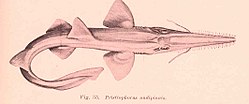Pristiophoriformes
| Sawsharks Temporal range: Upper Jurassic–recent |
|
|---|---|
 |
|
| Shortnose sawshark, Pristiophorus nudipinnis | |
| Kingdom: | Animalia |
| Phylum: | Chordata |
| Class: | Chondrichthyes |
| Subclass: | Elasmobranchii |
| Superorder: | Selachimorpha |
| Order: |
Pristiophoriformes L. S. Berg, 1958 |
| Family: |
Pristiophoridae Bleeker, 1859 |
| Genera | |
|
|
The sawsharks or saw sharks are an order (Pristiophoriformes) of sharks bearing long, blade-like snouts edged with teeth, which they use to slash and disable their prey. Most occur in waters from South Africa to Australia and Japan, at depths of 40 m (130 ft) and below; in 1960, the Bahamas sawshark was discovered in the deeper waters (640 m to 915 m) of the northwestern Caribbean.
Sawsharks have a pair of long about halfway along the snout. They have two dorsal fins, but lack anal fins, and range up to 170 cm (5.6 ft) in length. Genus Pliotrema has six gill slits, and Pristiophorus the more usual five. The teeth of the saw typically alternate between large and small.
These sharks typically feed on fish, squid, and crustaceans, depending on species. They cruise the bottom, using the barbels and ampullae of Lorenzini on the saw to detect prey in mud or sand, then hit victims with side-to-side swipes of the saw, crippling them.
Although they are similar in appearances, sawsharks are distinct from sawfishes. Sawfishes have a much larger maximum size, lack barbels, have evenly sized rather than alternating sawteeth, and have gill slits on their undersurface rather than on the side of the head.
Sawsharks and sawfishes are cartilaginous fishes possessing large saws. However, sawfishes are not sharks, but a type of ray. The gill slits of the sawfishes are positioned on the underside like a ray, but the gill slits of the sawshark are positioned on the side like a shark. Another clear difference is that a sawfish has no barbels and a sawshark has a prominent pair halfway along the saw. The sawshark uses these like other bottom fish, as a kind of antennae, feeling the way along the ocean bottom until it finds some prey of interest.
...
Wikipedia
